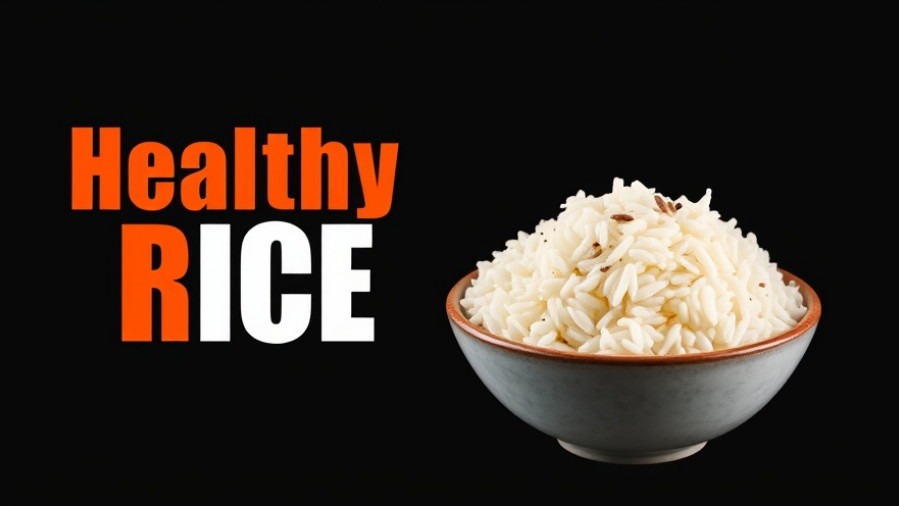
Unlock the Power of Rice for Healthy Aging
After reaching the age of 60, dietary changes can become increasingly crucial. Many people think that a simple bowl of rice is off-limits because of its potential to spike blood sugar and cause bloating. However, the truth is that rice can be a beneficial part of a senior's diet if prepared thoughtfully. Today, we explore five research-backed hacks that can empower seniors to enjoy rice without the common drawbacks, transforming it into a source of steady energy for heart health, gut well-being, and even better sleep.
In '5 Rice Hacks Seniors Need To LOWER Blood Sugar & Gut Health,' the discussion dives into innovative ways of preparing rice to enhance its health benefits for seniors, providing insights that are essential for improved aging.
1. Cooled and Reheated Rice: The Secret to Resistant Starch
One of the simplest changes seniors can make is to cool their cooked rice overnight before reheating it. This process not only alters the starch composition but produces what is known as resistant starch—a type that doesn't spike blood sugar levels. In fact, a study from Indonesia found that reheating rice that had been chilled for 24 hours significantly lowered the glycemic index. For seniors, this means more stable energy levels without the after-meal crash.
A patient of mine, Ellen, discovered the benefits of this practice firsthand. Previously fatigued after her afternoon rice bowl, she found renewed energy to engage with her granddaughter after adjusting her cooking method. “It felt wonderful to enjoy my meal without the crash,” Ellen shared.
2. Choosing High Amalo Rice: A Smart Switch for Stable Blood Sugar
Not all rice is created equal. The glycemic impact of rice is heavily influenced by its variety, particularly its amalo content—a form of starch known for its slow-digesting properties. Rice varieties like Dixie Bell and Rondo contain higher levels of this beneficial starch, helping to maintain more consistent blood sugar levels. A study out of Hawaii showed that these varieties result in lower blood glucose readings compared to standard white rice.
Frank, 68, realized this after switching to long-grain rice varieties. He noted a remarkable difference in his energy levels and was able to enjoy his meals without the usual evening crashes. When shopping for rice, look for “high amalo” or long-grain options to enhance your health while indulging in this staple food.
3. The Power of Pairing: Beans and Rice
Boosting the benefits of rice can be as simple as pairing it with beans. This combination not only enhances the nutritional value but also optimizes how your body processes the carbohydrates. Beans add protein and soluble fiber, which work together to slow down the digestion of rice starch, easing blood sugar spikes. A Costa Rican study showed that increasing the bean-to-rice ratio can cut the risk of metabolic syndrome significantly.
Luis, a caregiver for his mother, found that serving rice with black beans improved her digestion and provided more sustained energy. Making half your plate beans and half rice can keep meals hearty and nutritionally balanced—while also enhancing enjoyment.
4. Vinegar: A Kitchen Staple that Controls Blood Sugar
An often-overlooked ingredient, vinegar—particularly apple cider vinegar—can work wonders for blood sugar control. Its acetic acid content slows down starch digestion, facilitating a gradual release of glucose into the bloodstream. One pivotal study demonstrated that vinegar could decrease the glycemic index of certain foods by a remarkable 35%.
Marjorie, 74, started incorporating apple cider vinegar into her routine, combining it with water before meals. The result? More stable energy and better sleep patterns. This simple adjustment showcases how small dietary tweaks can lead to significant improvements in health.
5. Eating Rice at the Right Time
The timing of meals can greatly influence how rice affects your blood sugar. Studies indicate that consuming high-carb meals in the evening leads to increased glucose variations and disrupted sleep patterns. Conversely, enjoying rice during breakfast or lunch, when insulin sensitivity is higher, helps manage glucose levels more effectively.
George, age 70, found that merely shifting his rice consumption to earlier in the day made a world of difference. No more grogginess or restless nights—just deeper sleep and easier mornings. This connection between meal timing and energy stability exemplifies how individuals can work in harmony with their body's natural circadian rhythms.
Transforming Rice into a Healthy Staple
Rice doesn't have to be off-limits for seniors. With these actionable hacks, it can return to the table as a health-promoting choice that fosters energy stability, gut health, and improved sleep. As we champion healthier aging, it's vital to remember that food should not only nourish but also be enjoyed.
So how will you change your rice routine this week? Whether it's cooling leftovers, experimenting with high amalo rice, or simply adding beans to your meals, let your experiences encourage others. Remember, every mindful choice at mealtime is a step towards a healthier future—not just for you but for your loved ones as well.
If you found this information enlightening, consider subscribing to learn more about practical, science-backed tips for healthy aging. Your future self will thank you!
 Add Element
Add Element  Add Row
Add Row 




Write A Comment